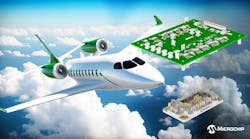By John McHale
GREENBELT, Md. - Engineers at NASA Goddard Space Flight Center in Greenbelt, Md., are using the LS Series of radiation-hardened DC-DC converters from International Rectifier (IR) in El Segundo, Calif., for their Solar Dynamic Observatory (SDO).
The SDO is the first Space Weather Research Network mission in the Living With a Star (LWS) Program of the National Aeronautics and Space Administration (NASA). SDO is being designed to help understand the Sun’s influence on Earth and near-Earth space by studying the solar atmosphere on small scales of space and time and in many wavelengths simultaneously, NASA officials say.
This was a project NASA officials came to IR about, says Mike Sullivan, director of business management, Multichip, Hi-Rel products at IR. They needed a DC-DC converter in a smaller package than what was available on the market.
IR had products that separately met the power and size requirements NASA was looking, then combined them into one product for NASA’s requirements, Sullivan says. The LS is used throughout the observatory, he adds. The LS Series came out of this contract, Sullivan says. The product line was announced last month.
The 30-watt LS Series family includes a MIL-STD-461-compliant EMI filter and is to provide cost and space saving, IR officials say. The design incorporates circuitries enabling low output voltage operations for new field programmable gate arrays (FPGAs) and digital signal processing (DSP) technology.
These converters are for applications such as low-Earth orbit (LEO), middle-Earth orbit (MEO), geostationary Earth orbit (GEO), and scientific missions that have long-life requirements of as long as 15 years or resistance to 100 kilorads of radiation design requirements.
The key features include an 18-to-40-volt input range; SEE LET (heavy ions) more than 82 MeV.cm2/mgi; magnetically coupled feedback; efficiency to 85 percent; adjustable output voltage; and a mean time between failure of 4 million hours.
The LS Series of DC-DC converters provide the same mechanical outline, power ratings, and backward pin compatibility as their counterparts with lower tolerance to radiation-the M3L and Military Series ATS DC-DC converters. The common platform design allows for similarity between military and space system architectures.
The LS Series of converters incorporates a fixed-frequency single forward topology with magnetic feedback and an internal EMI filter. These converters meet the conducted emissions requirements of MIL-STD-461C without additional components.
All models include an external inhibit port and have an adjustable output voltage. They are enclosed in a hermetic 1.5-by-2.3-by-0.425-inch steel package and weigh 85 grams. The package uses rugged ceramic feed-through copper core pins and is sealed using parallel seam welding.
Nonflight versions of the LS Series converters are available for system development purposes. These devices are manufactured with the same generic active circuit elements but do not have guaranteed radiation performance, IR officials say. Variations in electrical specifications and screening to meet custom requirements can be accommodated.
The converter will resume normal operation when the load current is reduced below the current limit point. This protects the converter from overload and short circuit conditions. The current limit point exhibits a slightly negative temperature coefficient to reduce the possibility of thermal runaway.
For more information see www.irf.com. For more on the Solar Dynamic Observatory see http://sdo.gsfc.nasa.gov.


